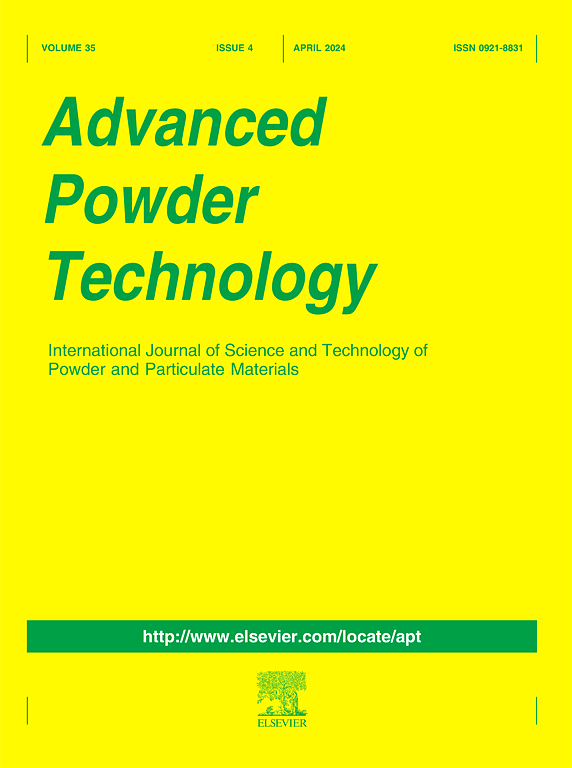CO2-to-propane hydrogenation over bifunctional catalysts composed of Pd-loaded ZnZrOx and SAPO-34
IF 4.2
2区 工程技术
Q2 ENGINEERING, CHEMICAL
引用次数: 0
Abstract
We conducted CO2-to-propane hydrogenation using bifunctional catalysts composed of Pd-loaded Zn-doped ZrO2 and SAPO-34, and investigated the effect of Pd loading and reaction conditions on propane production. Three catalysts with different Pd loadings (0–0.2 mol%) were prepared to evaluate the influence of Pd content on catalytic performance. A small amount of Pd significantly enhanced paraffin selectivity, increasing it from approximately 50 % to nearly 100 %, without affecting the total hydrocarbon yield. This effect is attributed to the hydrogenation of olefins over metallic Pd. In contrast, excess Pd loadings promoted the reverse water–gas shift reaction, leading to lower methanol and hydrocarbon production. The reaction was conducted at a larger scale than previously reported, under conditions of 4 MPa and 350 °C, using 850 mg of catalyst and a feed gas flow rate of 30 mL(STP) min−1. Under these conditions, a propane yield of 5.0 %, a space–time yield of 0.95 mol kg−1 h−1. Of note, a propane formation rate of 0.80 mmol h−1 were achieved, which is twice as high as values reported in earlier studies.

负载pd的ZnZrOx和SAPO-34双功能催化剂催化二氧化碳加氢制丙烷
采用负载Pd掺杂zn的ZrO2和SAPO-34组成的双功能催化剂对co2加氢制丙烷进行了研究,并考察了负载Pd和反应条件对丙烷产量的影响。制备了3种不同Pd负载(0 ~ 0.2 mol%)的催化剂,考察了Pd含量对催化性能的影响。少量Pd显著提高了石蜡的选择性,将其从约50%提高到近100%,而不影响总烃收率。这种效应归因于烯烃在金属钯上的氢化反应。相反,过量的Pd负载促进了逆向水气转换反应,导致甲醇和碳氢化合物产量降低。实验条件为4mpa, 350℃,催化剂用量为850 mg,进料气流速为30 mL(STP) min - 1,反应规模比之前报道的要大。在此条件下,丙烷的产率为5.0%,时空产率为0.95 mol kg−1 h−1。值得注意的是,丙烷的生成速率达到了0.80 mmol h - 1,这是早期研究报告的两倍。
本文章由计算机程序翻译,如有差异,请以英文原文为准。
求助全文
约1分钟内获得全文
求助全文
来源期刊

Advanced Powder Technology
工程技术-工程:化工
CiteScore
9.50
自引率
7.70%
发文量
424
审稿时长
55 days
期刊介绍:
The aim of Advanced Powder Technology is to meet the demand for an international journal that integrates all aspects of science and technology research on powder and particulate materials. The journal fulfills this purpose by publishing original research papers, rapid communications, reviews, and translated articles by prominent researchers worldwide.
The editorial work of Advanced Powder Technology, which was founded as the International Journal of the Society of Powder Technology, Japan, is now shared by distinguished board members, who operate in a unique framework designed to respond to the increasing global demand for articles on not only powder and particles, but also on various materials produced from them.
Advanced Powder Technology covers various areas, but a discussion of powder and particles is required in articles. Topics include: Production of powder and particulate materials in gases and liquids(nanoparticles, fine ceramics, pharmaceuticals, novel functional materials, etc.); Aerosol and colloidal processing; Powder and particle characterization; Dynamics and phenomena; Calculation and simulation (CFD, DEM, Monte Carlo method, population balance, etc.); Measurement and control of powder processes; Particle modification; Comminution; Powder handling and operations (storage, transport, granulation, separation, fluidization, etc.)
 求助内容:
求助内容: 应助结果提醒方式:
应助结果提醒方式:


